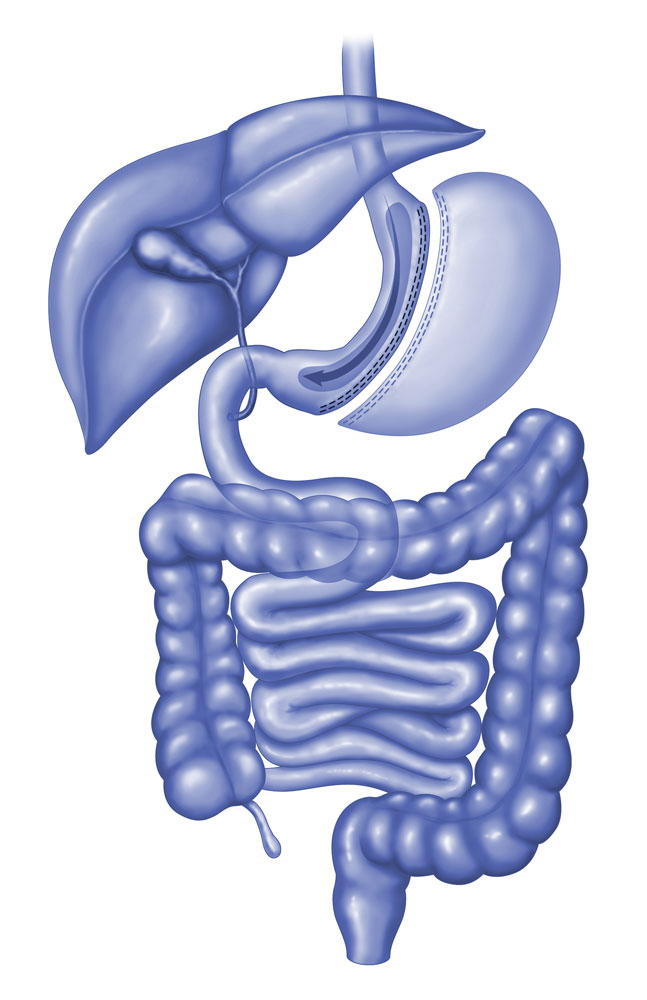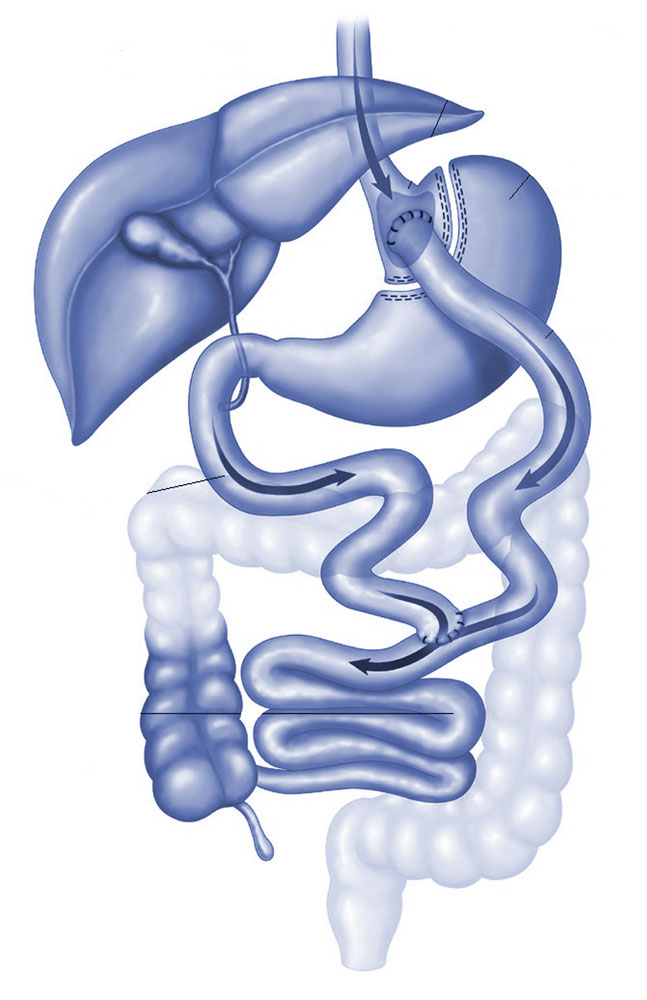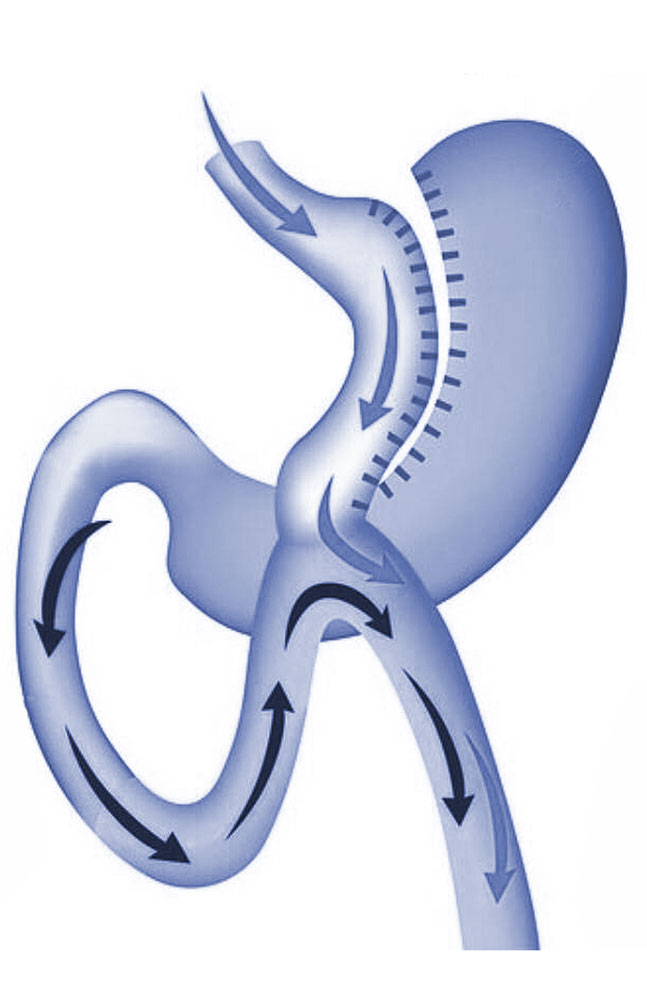Questions? Call Us Now: 888-344-3916
Discover the Best Option for
Your New You
SCHEDULE A CONSULTATION
Bariatric Surgery Options
Obesity, a disorder involving an excessive amount of body fat, has become a global problem. The obesity epidemic can be contributed to modern environmental factors such as poor diet, stress, lack of exercise, sleeping habits, and pharmaceuticals. Diet and exercise alone are not an effective, long-term solution to weight loss.
Research studies have discovered two factors pointing to the reduced efficacy of diet. First is the body’s natural resistance to weight loss and the second, is the body’s tendency to put the weight back on after you’ve lost it.
The body sees calorie reduction diet (Calories In less than Calories Out) as a starvation threat. And body’s natural resistance to weight loss can be described as the increased feelings of cravings and hunger while simultaneously decreasing the metabolism and satiety. These two mechanisms will keep most individuals from losing any considerable weight. Body fat setpoint is affected by Genetic Predisposition, Environmental Exposure, and Developmental History.
Even after you succeed to lose the weight, your body will typically try to go back to your previous ‘set point,’ meaning the body may encourage excess weight to regain. As if your body will remember the initial ‘set point.’ This could cause a vicious cycle and it is known as weight cycling or yo-yo diet
Surgical treatment of obesity or bariatric surgery is a proven solution to reducing obesity. Obesity surgery works so well because it changes the physiology and creates a new ‘set point,’ in patients. Causing them to keep the weight off for the long-term.
There are a lot of options to lose weight via surgery because there isn’t one bariatric surgery that is ideal for everyone. Each patient has their characteristics that will dictate which surgery is best for them.
This is a very long post and even though we recommend reading it all, here we have an index to help you find information about a specific Surgery:
Have An Expert Help You Find The Surgery For You
Gastric Sleeve

Stomach Alterations
Stomach size reduced
The stomach is reduced permanently by removing 75 to 80 percent of the stomach.
Changes to Intestine
No Change
There are no changes to the intestines during this surgical procedure.
Operating Time
1 hours
Average Hospital Stay
2 to 3 days
Time Off Work
2 Weeks
Recovery Time
The average recovery time following a gastric sleeve procedure is 3 weeks. This is a laparoscopic procedure with a short recovery time. You may need pain medication to help get you through the recovery period though you will have a small amount of discomfort compared to other weight loss surgery procedures.
Pros
The gastric sleeve does not change the way your stomach is emptied. This has several advantages in the long run.
This is a quick and minimally-invasive procedure with a short recovery time.
The risks and complications you have after surgery are also minimal.
Disadvantages
There tend to be fewer people who lose a large amount of weight after gastric sleeve surgery and the stomach may expand over time causing weight gain.
The procedure is not reversible.
Surgery Description
The gastric sleeve procedure is done by removing part of the stomach and making a tube-shaped sleeve where the food will then be digested. This reduces how much is eaten during each meal, resulting in weight loss. This is a laparoscopic procedure, with very minimal incisions used.
Realistic Expectations
Over 90% of our patients lose 96% of their excess weight in 12 months.
Post Surgery Dietary Info
After surgery, patients are instructed to follow a phase diet. It has four stages, beginning with clear liquids, followed by full liquids, soft foods, and then regular foods. Calcium supplements, vitamin B12, and multivitamins are recommended.
Candidate Efficacy
Patients who are obese or in the high-risk category according to their BMI make great candidates for the procedure.
Have An Expert Help You Find The Surgery For You
RNY Gastric Bypass

Stomach Alterations
New Stomach is Created: Stoma.
A small pouch is created with the upper part of the stomach. This small pouch will be connected to the intestines and will empty via this connection, called the stoma. The remaining stomach is sealed off, food will no longer be held there.
Changes to Intestine
Cut and Bypassed
The intestines are cut and bypassed during the RNY gastric bypass procedures. This allows it to be malabsorptive of calories and nutrients as well.
Operating Time
2 hours 40 min average.
Average Hospital Stay
3 to 4 days
Time Off Work
2 weeks.
Recovery Time
The average recovery time for RNY gastric bypass is typically four to six weeks. You are not able to drive on your own for at least 10 days and are instructed to follow all post-op instructions, including taking medications and not returning to normal activities until directed by a doctor.
Pros
It is both a restrictive and a malabsorptive procedure which permits patients to lose weight in 2 ways.
It also helps with other medical conditions, including diabetes, hypertension, osteoarthritis, GERD, and sleep apnea.
Disadvantages
Some patients experience dumping when eating foods high in fat and sugar. Stoma may stretch over time, which may lead to weight gain. Chances of a surgical complication are higher. Post surgical complications like internal hernias, ulcers and stricture are more common. Not committing to the post surgery supplement regimen may result in nutrient deficiencies.
Surgery Description
A small pouch attached to the small intestine is created during the RNY gastric bypass procedure. In addition intestines are bypassed to reduce the caloric absorption.
Realistic Expectations
On average, patients lose between 77 percent and 80 percent of their excess body weight in the first 2 years after the surgery.
Post Surgery Dietary Info
After surgery, it is important to drink enough water for staying hydrated, taking recommended vitamins and minerals, and eating enough protein. You are advised to eat four small meals a day and avoid high fat food as they lead to dumping syndrome. Eat and drink slowly, do not drink through a straw, and do not drink during meals. Take vitamin B12, zinc and iron.
Candidate Efficacy
Patients with a BMI of 35-55 are suitable candidates for RNY gastric bypass.
Some patients outside this BMI range may be candidates if they present certain comorbities like diabetes, GERD, etc.
Have An Expert Help You Find The Surgery For You
Mini Gastric Bypass

Stomach Alterations
New Stomach is Created: Stoma.
A small pouch is created with the upper part of the stomach. This small pouch will be connected to the intestines and will empty via this connection, called the stoma. The remaining stomach is sealed off, food will no longer be held there.
Changes to Intestine
Also called the single anastomosis bypass. Intestines are bypassed and joined with the new pouch. It is a less malabsorbic procedure when compare to the RNY gastric bypass.
Operating Time
3 hours
Average Hospital Stay
2 to 3 days
Time Off Work
2 to 3 Weeks
Recovery Time
On average, recovery takes a six to eight weeks. You are released from the hospital in just a couple days, but you will need a few months before you can return to all of your normal activities following the procedure.
Pros
There is a very large amount of weight loss with the mini gastric bypass, making it one of the top benefits.
It also has very few incisions and is done as minimally invasive as possible.
This is a safer and shorter procedure than the traditional gastric bypass.
Disadvantages
Some patients experience dumping when eating foods high in fat and sugar. Stoma may stretch over time, which may lead to weight gain. Chances of a surgical complication are higher. Post surgical complications like internal hernias, ulcers and stricture are more common. Not committing to the post surgery supplement regimen may result in nutrient deficiencies.
Surgery Description
Mini gastric bypass is done by creating a small pouch using a laparoscopic stapler for the stomach. The majority of the stomach isn’t attached to the esophagus, and food bypasses the larger part of the stomach after the procedure.
Realistic Expectations
Within the first year after surgery, patients can lose up to 70 percent of their excess body weight. The majority of patients have kept the weight off, up to 95 percent of patients that had success with the surgery.
Post Surgery Dietary Info
After surgery, it is important to drink enough water for staying hydrated, taking recommended vitamins and minerals, and eating enough protein. You are advised to eat four small meals a day and avoid high fat food as they lead to dumping syndrome. Eat and drink slowly, do not drink through a straw, and do not drink during meals. Take vitamin B12, zinc and iron.
Candidate Efficacy
Patients with a BMI of 35-55 are suitable candidates for mini gastric bypass.
Some patients outside this BMI range may be candidates if they present certain comorbities like diabetes, GERD, etc.
Have An Expert Help You Find The Surgery For You
Gastric Banding

Stomach Alterations
Stomach size reduced
With the gastric band implant, the stomach size is reduced. It can be removed or adjusted as needed.
Changes to Intestine
No Change
There are no changes to the intestine.
Operating Time
45 minutes.
Average Hospital Stay
2 to 3 days
Time Off Work
One week
Recovery Time
2 weeks.
Pros
The advantages of the gastric banding procedure include being a reversible process and a simple and quick procedure to complete.
It is also adjustable, which helps you lose weight over an extended period.
This fact that it is adjustable also contributes to reducing risks and complications.
Disadvantages
Patients may experience reflux and vomiting due to the very small opening created with the band. Band slippage and erosion may occur which may lead to band removal.
Surgery Description
Gastric banding is done by placing an implanted silicone ring around the upper part of the stomach. This separates the stomach with a smaller pouch on top where the food goes, avoiding the larger part of the stomach.
Realistic Expectations
Patients have been known to lose around 50 percent of their excess body weight and keep it off in the long-term. This is one of the most difficult weight loss surgeries to manage for continued weight loss, and requires diet and exercise.
Post Surgery Dietary Info
Follow a liquid diet for three weeks then slowly add in solid foods. Eat 4 small meals a day aiming for no more than 1,000 healthy calories a day.
Candidate Efficacy
Gastric banding is most useful for patients that are more disciplined in following a strict diet and will commit to an exercise program. Suitable candidates are committed to weight loss.
Have An Expert Help You Find The Surgery For You
Duodenal Switch

Stomach Alterations
Stomach size reduced
The duodenal switch is an irreversible procedure that makes a permanent stomach alteration. Approximately 75% of the stomach is removed forming a sleeve.
Changes to Intestine
Intestines “Switched.”
Also known as the Biliopancreatic Diversion with Duodenal Switch. The small intestines as rerouted creating 2 separate pathways and one common channel.
Operating Time
4 to 5 hours
Average Hospital Stay
3 to 4 days
Time Off Work
3 Weeks
Recovery Time
Recovery time for the duodenal switch is about four to six weeks, though this varies based on the person. It is laparoscopic so only small incisions are made, but the inside takes longer to heal.
Pros
Has the highest level of weight loss of all weight loss procedures and best long-term statistics for keeping the weight off long term. Best surgery to solve diabetes and other comorbidities.
Disadvantages
Technically it is the most difficult surgery to perform. Higher risk of complications, nutrient deficiency and gas.
Surgery Description
Restrictive and Malabsorptive procedure. 75% of the stomach is removed and intestines are rerouted to have a common channel where food and bill will mix and absorption will take place. The limited area where food is absorbed results in significant weight loss.
Realistic Expectations
Patients experience significant weight loss with the DS. You can expect to lose between 80 to 100 % of your excess weight.
Post Surgery Dietary Info
A phased diet for 4 weeks will be recommended. Vitamin and mineral supplements and protein supplements are a must to avoid malnutrition. Certain sugars, high fat foods, etc. may have to be avoided permanently to avoid diarrhea.
Candidate Efficacy
The Duodenal Switch has a higher incidence of complications than any other weight loss surgery.
Patients with a BMI of 40 or more can get the duodenal switch. There may be certain exception for patient outside the BMI range if certain comorbidities are present.